Here’s a dish that is the South Indian variant of the North Indian suji ka halwa. Meet Kesari Recipe – a popular, delicious South Indian sweet dish made with rava or suji (cream of wheat or semolina), sugar, ghee (clarified butter), saffron, nuts and dry fruits. This melt-in-mouth, orange colored preparation is also referred to as Rava Kesari Recipe. Make this decadent sweet treat with my simple recipe that I have shared with step-by-step pictures and video.

About Kesari Recipe
Kesari is a pudding like sweet that is good to look at as it is to eat. To make this delicious sweet dish the rava is roasted/toasted in ghee until the fine rava granules become fragrant and change color.
Later a bubbling hot sugar syrup is added to the well roasted rava and this mixture is cooked further until it thickens and all the water has been absorbed. Lastly green cardamom powder and fried cashews, raisins are added for more flavors.
Kesari Recipe is common during festivals as well as poojas, auspicious occasions or any other celebrations in South India. It is also made and offered to the deities in many temples in South India.
Table of Contents
In Hindi, ‘rava’ is known as ‘sooji’ and in English, it is known as ‘semolina or cream of wheat.’ The word ‘kesari’ means an orange or yellow color and in some instances also means ‘saffron’ that is ‘kesar’ in Hindi. So, basically Rava Kesari Recipe is an orange hued dessert of semolina pudding flavored with saffron.
So, the main ingredients in this Kesari Recipe are rava, ghee, sugar, water and saffron or orange food color. The recipe is quite simple, if you follow it well and will not give you sleepless nights too!

Rava Kesari vs Suji Halwa
Like I mentioned in the beginning, the North Indian counterpart of Kesari Recipe is Suji Ka Halwa, an equally popular and delectable dessert. In Maharashtra and Gujarat, this same dish is called as sheera.
However, there are some more variations in the preparations of sooji halwa, sheera and Rava Kesari recipe. The difference between this Kesari Recipe and suji halwa or sheera is majorly the color.
Sheera and suji halwa are not yellow or orange colored. Also, more quantity of ghee and sugar are used in the South Indian style Rava Kesari Recipe as compared to sooji halwa or sheera.
In Karnataka, Kesari Recipe variant is called as Kesari Bath. For breakfast, both Khara Bath (uppittu or upma) and Kesari Bath are served together. This is a famous combination called as Chow Chow Bath there.
About My Recipe
Like I said earlier, Kesari Recipe has a typical orange color. Usually, synthetic orange food color is added in it. Since I don’t use any synthetic colors in food, I use saffron and a natural orange color extract to bring in the orange hue. Remember that the addition of only saffron will give yellow tones and not orange.
In addition to the color, saffron gives a nice flavor and aroma as well in the Kesari Recipe. If you want orange tones, then add orange food color. I suggest using a natural orange color or natural yellow color extract.
Addition of ghee and sugar can always be minimized in my Kesari Recipe, while you are making it at home. In this recipe, I have added slightly less quantities of both ghee and sugar. But feel free to add more sugar or ghee according to your preferences.
I often prepare this traditional sweet as naivedyam for the deities or during Indian festivals like Ganesh Chaturthi, Navratri, Janmashtami, Ugadi and Diwali.
How to make Kesari Recipe
Fry Cashews and Raisins
1. In a heavy kadai or a thick bottomed frying pan, take 6 tablespoons ghee.

2. Heat ghee on medium-low heat till it melts completely.

3. Add 3 to 4 tablespoons cashews.
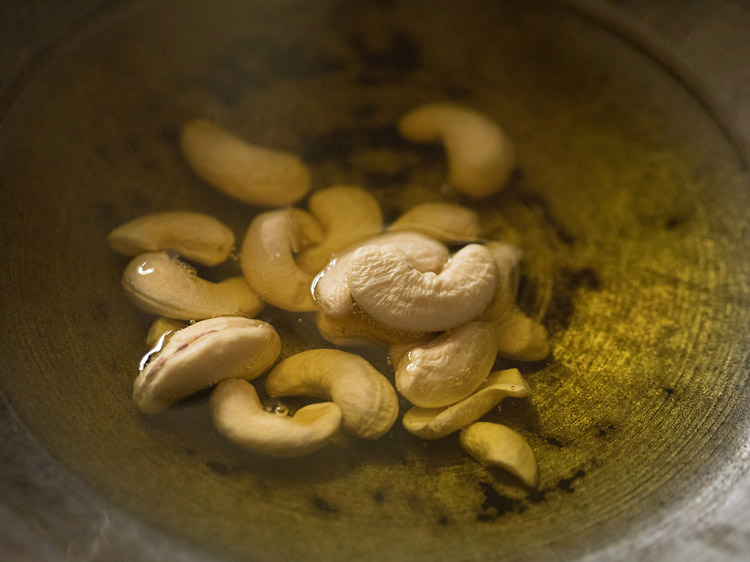
4. Begin to fry cashews, stirring them often.

5. Fry cashews till golden. Remove with a slotted spoon and keep aside on kitchen paper towel or in a plate.

6. Next, add 1 tablespoon raisins in the hot ghee.
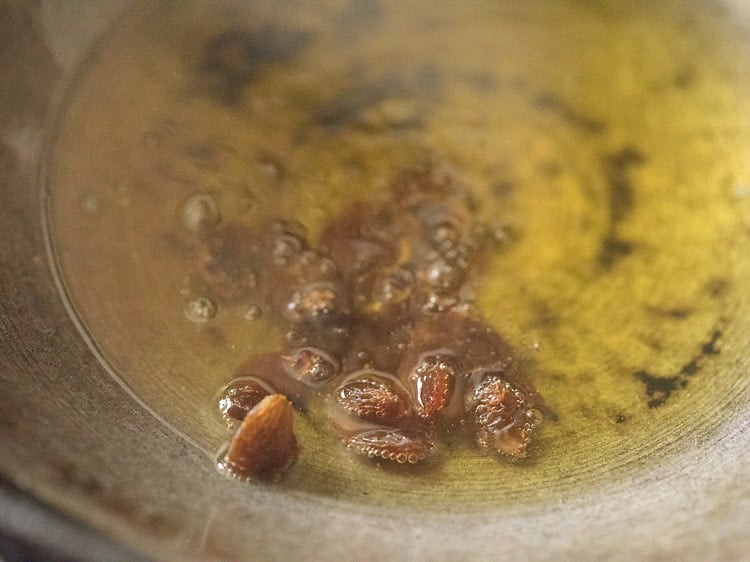
7. Stirring continuously, fry the raisins.

8. The raisins will become plump and swell.
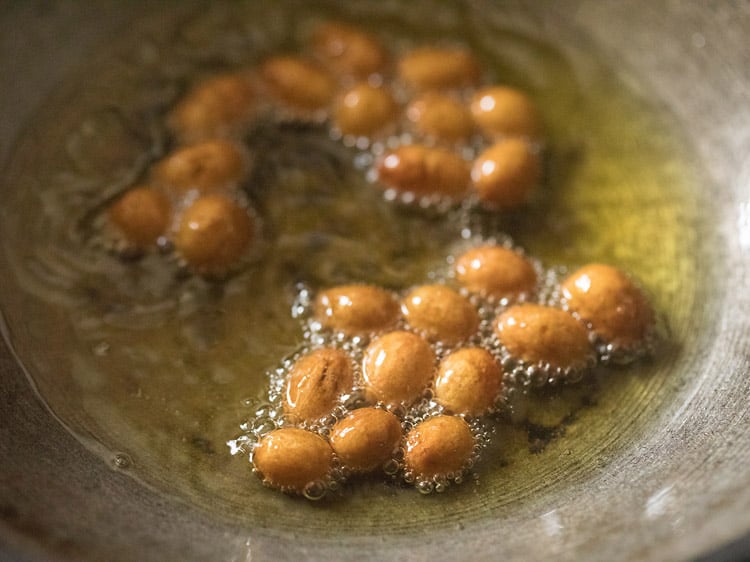
9. As soon as the raisins become plump, remove them and keep aside along with the fried cashews.
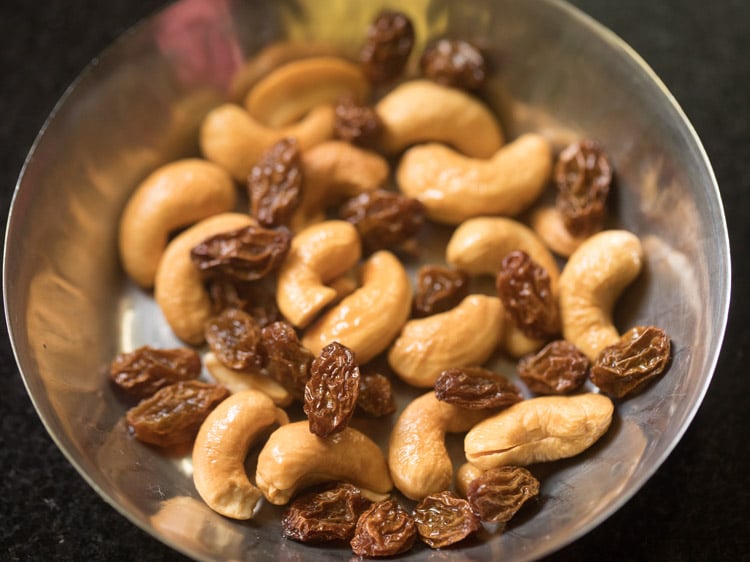
Roast Rava
10. Reduce heat to low and add 1 cup (160 grams) fine rava to the ghee.

11. Combine and mix the rava with the ghee.
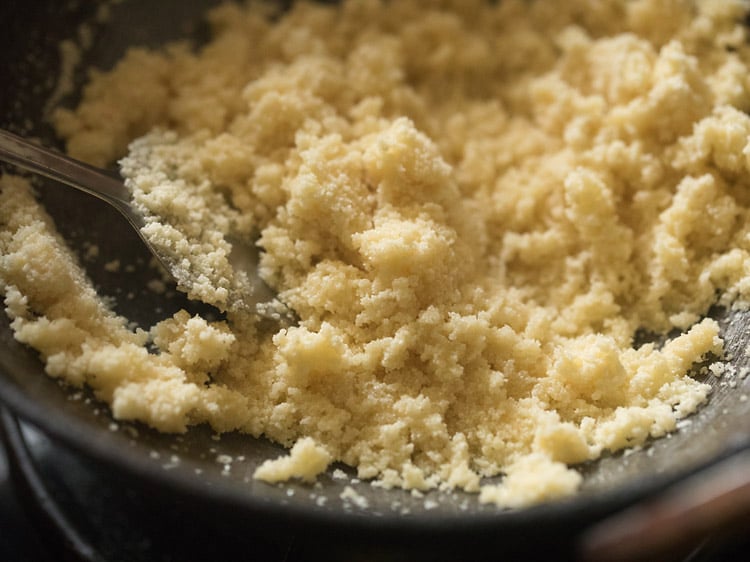
12. Begin to roast rava on low to medium-low heat. Stir often so that rava roasts evenly.
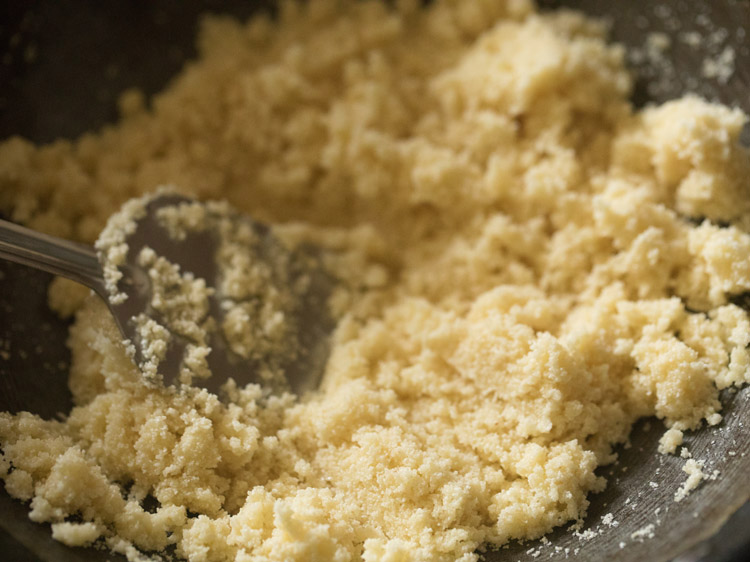
13. Stir frequently, while roasting rava, for even cooking.

14. The color of the rava should not become brown. Roasting rava takes about 9 to 11 minutes on low to medium-low heat.
Timing will vary with the type and make of the kadai or pan and the heat intensity.

15. Roast till you can see the ghee getting separated and the color of rava will also change. A nice aroma will also emanate from the roasted rava.

Make Sugar Syrup
16. When you begin to roast rava, at that time, take ¾ cup (190 to 200 grams) sugar in a saucepan. The sugar syrup needs to be cooked simultaneously while roasting rava.

17. Add 2 to 3 pinches of saffron strands.
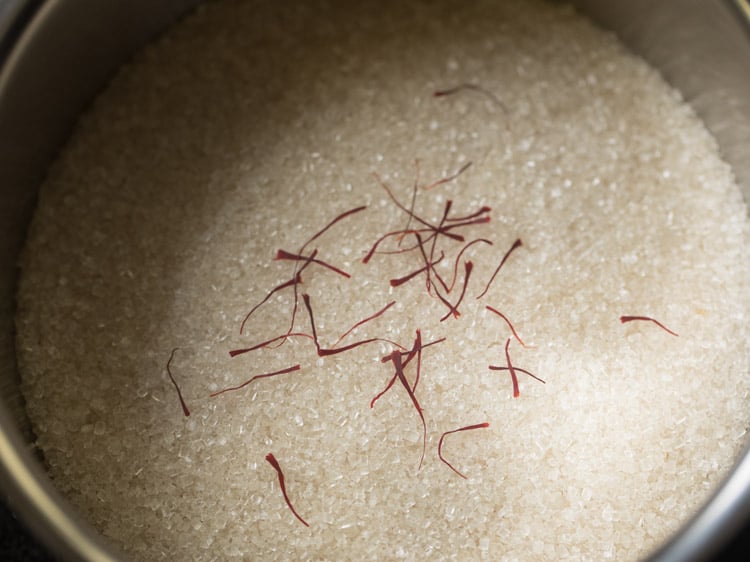
18. Add 2.5 cups water. Optionally, you can also add a natural yellow or orange color extract. I added 2 drops of natural orange color extract.
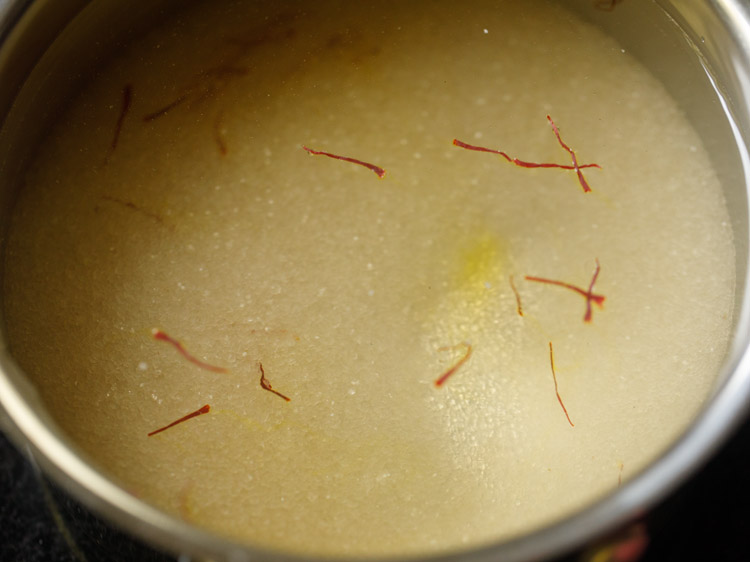
19. Keep the pan on stovetop and on medium to medium-high flame, begin to heat the sugar solution.
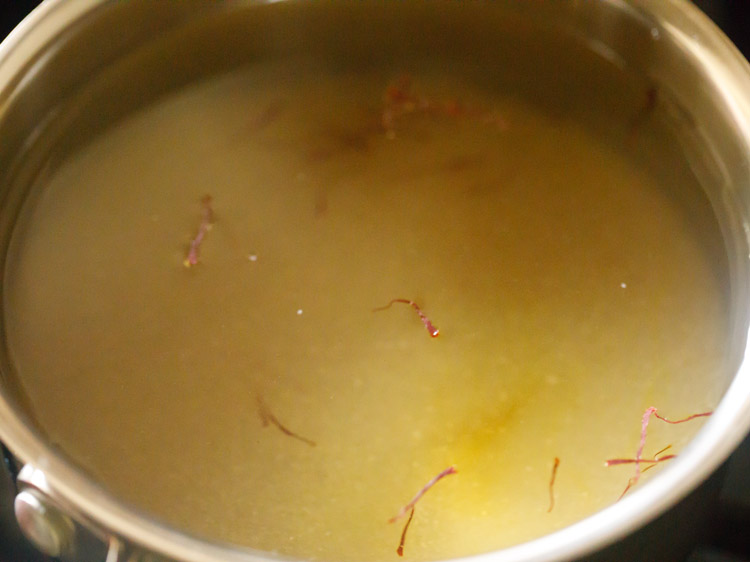
20. When you keep the pan on the stovetop for heating, at that time, stir with a spoon so that all the sugar is dissolved.
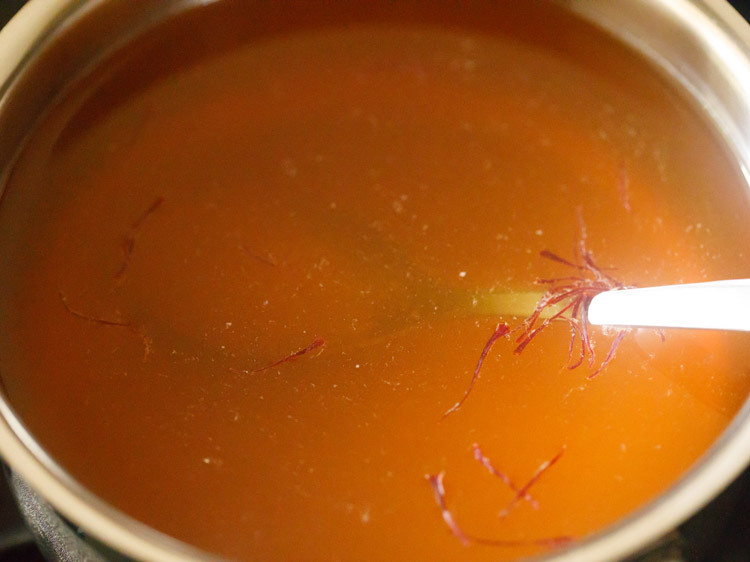
21. Bring this sugar syrup to a rolling boil.
In case the sugar syrup has come to a boil, but rava has not yet roasted, then reduce the heat to low and simmer the sugar syrup for a couple of minutes. So that it stays hot.
However, do not simmer for a long time as then the sugar consistency will change and the syrup can become sticky or have the sugar thread consistencies.
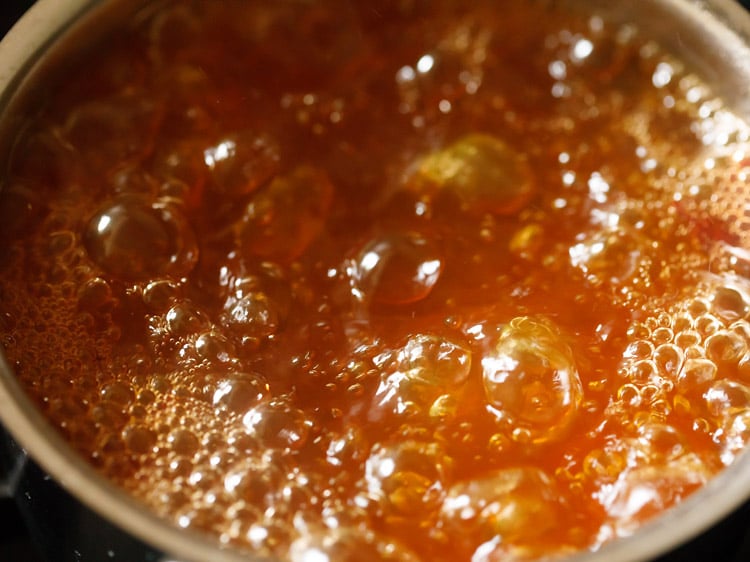
Make Kesari Recipe
22. By the time the sugar syrup starts boiling, the rava will also get roasted well.

23. Lower the heat and carefully pour the prepared sugar syrup in the hot ghee-rava mixture in a steady and slow stream.
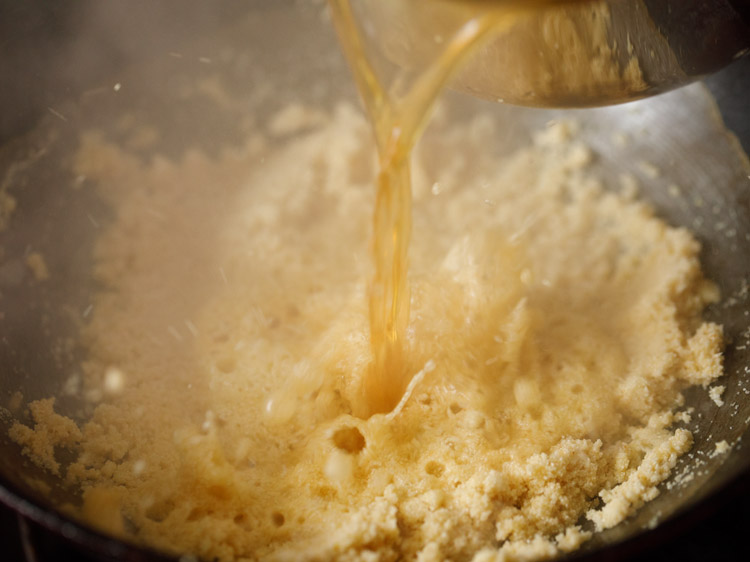
24. Take care while pouring as the mixture splutters.
In this Kesari Recipe, lumps are not formed as the quantity of water is more. In case if lumps form, then just break them with the spatula or spoon.

25. Stir and mix very well. Break lumps, if any, while mixing.

26. Cook the mixture on low to medium-low heat, stirring often.

27. The rava will absorb the water and swell and the mixture will begin to thicken. It will be soft and moist and the consistency will be like that of smooth pudding.

28. When the mixture starts thickening, add the fried cashews and raisins, reserving a few for garnishing.

29. Also, add ½ teaspoon green cardamom powder.
At this step, you can also add a pinch of edible camphor, if you want.

30. Mix very well.

31. Stir till the mixture releases some ghee and the rava has absorbed all the water and cooked well.
Also, you should not see any whitish or creamish tiny specks on the rava. If you see, then this means that the rava is still not cooked well.
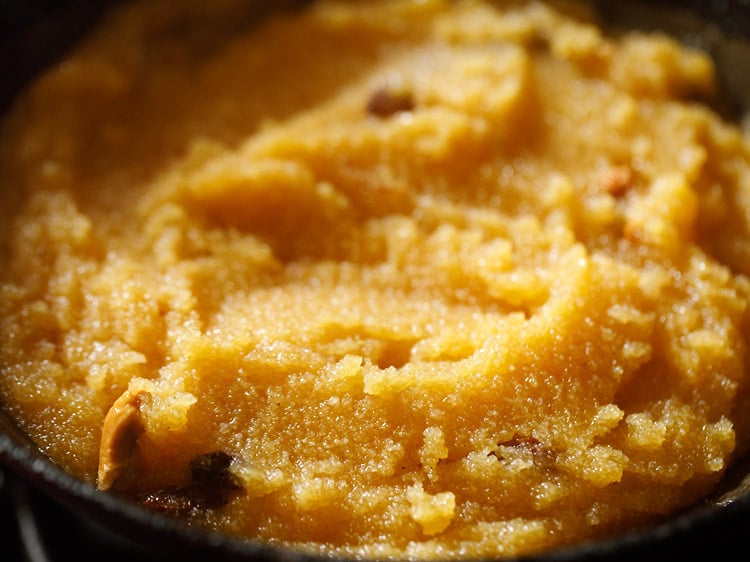
Steam Further
32. Turn off the heat and cover the pan for 5 minutes, just to allow the Kesari to steam.
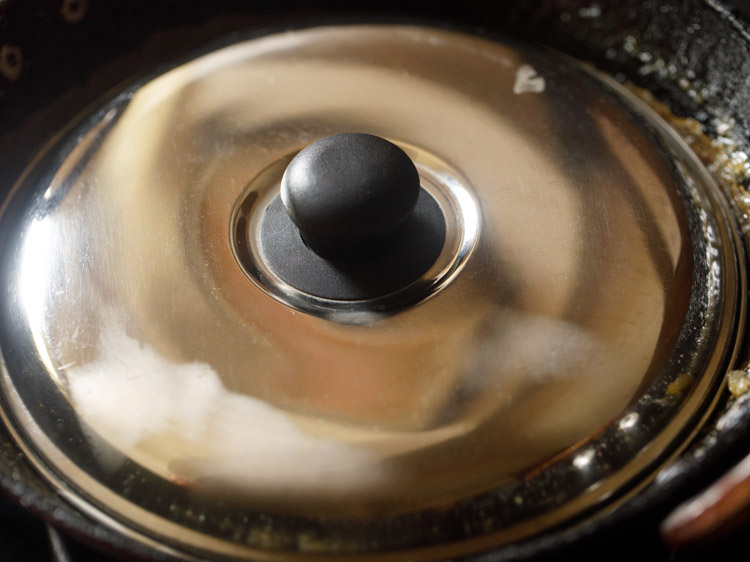
33. After 5 minutes, remove the lid and give a stir.
If you want to make slices, then immediately pour the Rava Kesari in a steel pan or tray. Spread evenly and when warm or cooled, cut into diamond-shaped or square slices.
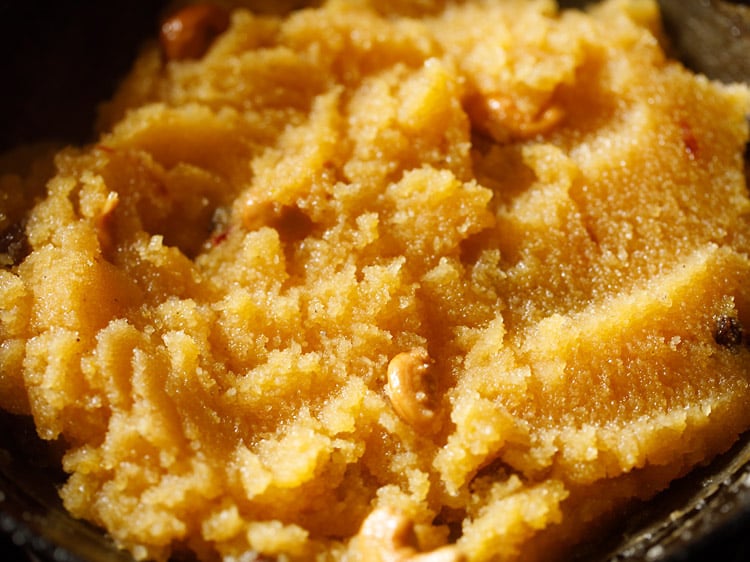
34. Serve Rava Kesari hot or warm. Garnish with the reserved fried cashews and raisins, while serving. You can also serve it as a sweet dish.
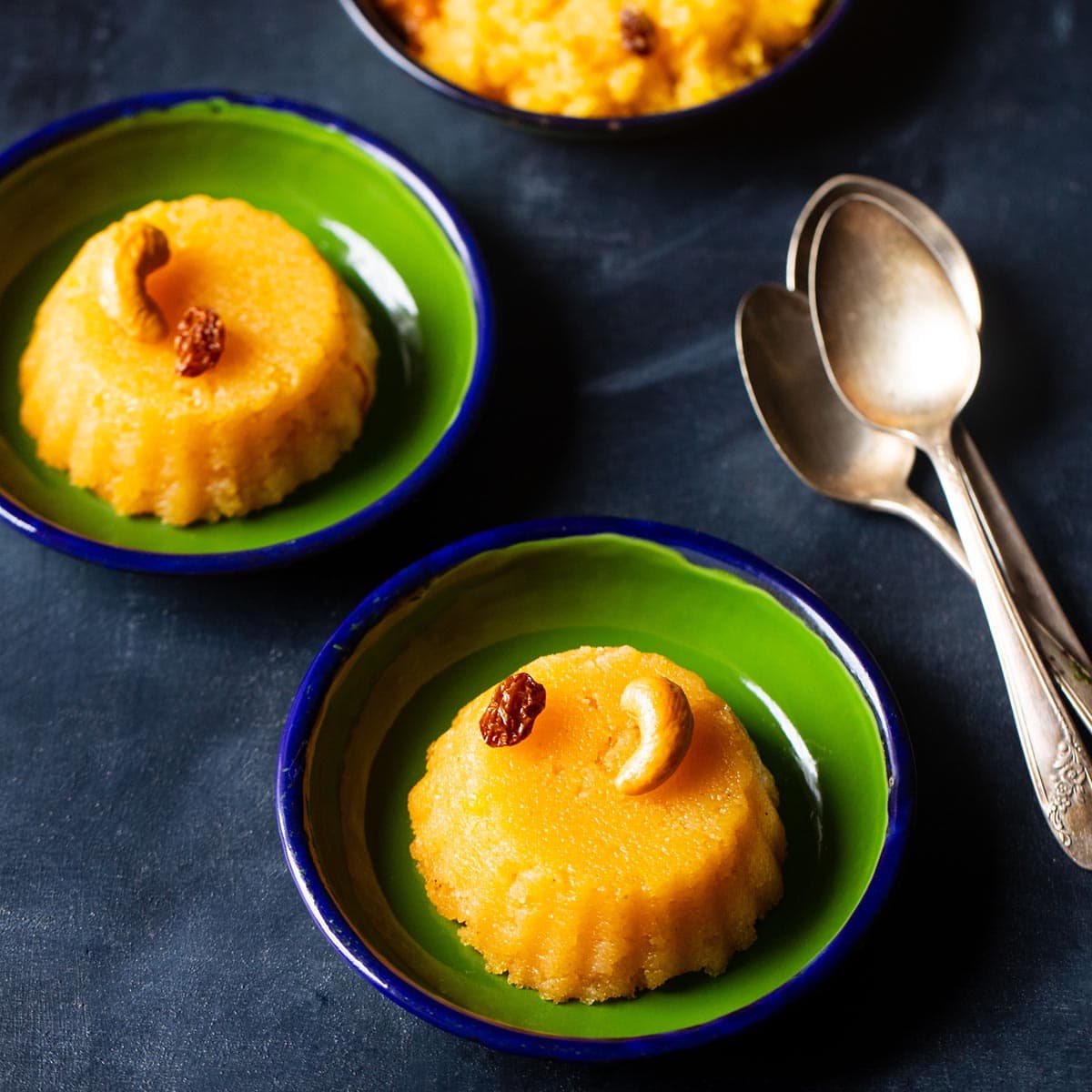
Serving Suggestions and Storage
You can prepare the Rava Kesari Recipe and relish it hot or warm. Garnish with a few of the reserved fried cashews and raisins, while serving.
It can also be served as a sweet dish. You can eat it as-is, without any sides. Store leftovers in a covered container in the refrigerator for 1 to 2 days.
Reheat in a skillet or frying pan by gently sautéing it or steam for a few minutes in a pan adding water as needed.
Expert Tips
- Type of rava: Use fine rava like Bombay rava or chiroti rava for a melt-in-mouth texture. If you live outside India, look for cream of wheat or fine semolina. You can also buy the rava or sooji online, or opt to use packaged roasted rava. Make sure that the rava is roasted well. Sometimes, readymade roasted rava is not properly roasted.
- Roasting rava: Remember to roast the rava very well. This step is important because if not done well, you will not get the perfect texture in the dish. There will also be a slight raw taste. Stir frequently while roasting rava, for even cooking. The rava will release ghee once it is roasted well and have a nice toasted fragrance too.
- Liquids: You can use milk instead of water. This makes the dish richer. Use same quantity of milk as the quantity of water mentioned in the recipe. You can also add equal proportions of water and milk.
- Adding liquids: When adding the sugar solution to the hot rava-ghee mixture, make sure that the sugar solution is bubbling hot. So, you have to cook them simultaneously. Add the sugar solution slowly and carefully as the rava mixture splutters.
- Proportion: To get a soft, nice texture dish, the proportion of rice and water to be used is 1:2.5 for both rava and water, respectively. You can even add 3 cups water, which gives a slightly moist dish. If your rava is coarser then also add 3 cups water.
- Nuts: The quantity of nuts and dry fruits can be varied and can be of your choice. But traditionally, cashews and raisins are added.
- Vegan option: To make this recipe vegan, replace the ghee with a neutral flavored oil.
Kesari Variations
Using the basic Kesari Recipe, many variations are possible. Add milk and you get the lovely milk kesari. Include mixed fruits or just one type of fruit and you get a nice fruity flavored version. Some more experiments that can be done with this base recipe are:
- Pineapple Kesari: A delish version made with chopped fresh pineapples. The pineapple gives a nice sweet tangy bite in the dish.
- Mango Kesari: During the mango season, you can try a version made with sweet or ripe mangoes.
- Semiya Kesari: This variant is unique as it is made with semiya or vermicelli. Thus, due to the addition of vermicelli, the texture and taste is very different.
More Halwa Recipes To Try!
Halwa Recipe
Halwa Recipe
Halwa Recipe
Halwa Recipe
Please be sure to rate the recipe in the recipe card or leave a comment below if you have made it. For more vegetarian inspirations, Sign Up for my emails or follow me on Instagram, Youtube, Facebook, Pinterest or Twitter.

Kesari Recipe | Rava Kesari
Ingredients
For frying cashews, raisins and rava
- 6 tablespoons Ghee (clarified butter)
- 3 to 4 tablespoons cashews
- 1 tablespoon raisins
- 1 cup rava – finer textured, 160 grams, (sooji or semolina or cream of wheat)
For sugar solution
- ¾ to 1 cup sugar or as add required – 190 to 200 grams
- 2.5 cups water or milk
- 2 to 3 pinches saffron strands – about 20 to 30 saffron strands
- 2 to 3 drops natural orange color extract – optional
Other ingredients
- ½ teaspoon green cardamom powder
- 1 pinch edible camphor – optional
Instructions
Frying cashews and raisins
- In a heavy kadai or a thick bottomed pan take 6 tablespoons ghee. Heat ghee on a medium-low flame till it melts completely.
- Add the cashews.
- Begin to fry cashews stirring them often till they become golden. Remove with a slotted spoon and keep fried cashews aside.
- Next add the raisins to the hot ghee.
- Stirring non-stop fry the raisins till they become plump and swell.
- Remove them and keep aside with the fried cashews.
Roasting rava
- Now reduce heat to a low and add the fine rava to the ghee. Mix well.
- Begin to roast rava on a low to medium-low heat.
- Stir frequently while roasting rava for even cooking.
- Roast till you can see the ghee getting separated and the color of rava will also change. A nice aroma will also emanate from the roasted rava.
- The color of the rava should not become brown.
- Roasting rava takes about 9 to 11 minutes on low to medium-low heat. But do note that the timing will vary with the type and make of the kadai or pan and the heat intensity.
Making sugar syrup
- When you begin to roast rava, at that time take the sugar in a saucepan. I added ¾ cup sugar.
- Add 2 to 3 pinches of saffron strands. You can also add a natural yellow or orange color extract. I also added 2 drops of natural orange color extract.
- Add 2.5 cups water.
- Keep the pan on stovetop and on a medium to medium-high flame begin to heat the sugar solution.
- When you keep the pan on the stove-top for heating, at that time stir with a spoon so that all the sugar is dissolved.
- Bring this sugar solution to a rolling boil.
Making rava kesari
- By the time the sugar solution starts boiling, the rava will also get roasted well.
- Lower the heat and now carefully pour the sugar-saffron solution in the well roasted ghee-rava mixture in a steady stream and slowly.
- Take care while pouring as the mixture splutters.
- Stir and mix very well. Break lumps, if any while mixing.
- Cook rava kesari mixture on a low to medium-low heat stirring often.
- The rava or sooji will absorb the water and swell and the mixture will begin to thicken.
- When the mixture starts thickening, add the fried cashews and raisins reserving a few for garnish.
- Also add the green cardamom powder. At this step you can also add a pinch of edible camphor if you want. Mix very well.
- Stir till the mixture releases some ghee and the rava has absorbed all the water and cooked well.
- Then turn off the heat and cover the pan for 5 minutes just to allow the rava kesari to steam.
- After five minutes, remove the lid. Stir rava kesari. If you want to make slices, then immediately pour it in a steel pan or tray. Spread evenly and when warm or cooled, cut into diamond shaped or square slices.
- Serve rava kesari hot or warm. You can also serve it as a side sweet dish with a South Indian lunch or dinner.
Video
Notes
- You can add a few tablespoons of more ghee or sugar if you want in the rava kesari.
- Remember to roast the rava very well to get the best texture in the dish.
- You can make a small batch of this recipe or scale it to feed a crowd.
- Instead of water you can use milk or equal proportions of both water and milk. Milk gives a richer taste to the kesari.
- If you use a coarser textured rava, add 3 cups of water. Also to make the sweet more moist and pudding like, you can opt to add 3 cups of water when using the finer textured rava.
- For a vegan kesari recipe, use a neutral tasting oil in place of ghee.
- You can vary the amount of nuts. Traditionally only cashews and raisins are added. But feel free to add nuts that you like.
Nutrition Info (Approximate Values)
This Rava Kesari recipe from the archives was first published on September 2013. It has been updated and republished on March 2023.

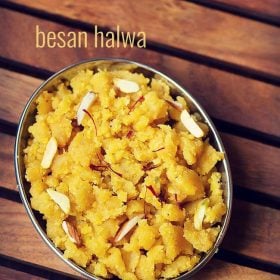
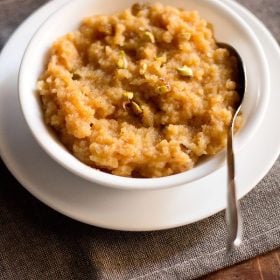
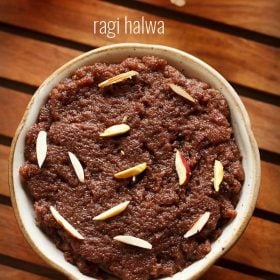
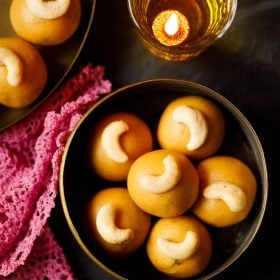
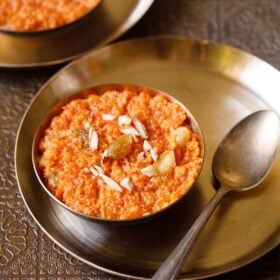
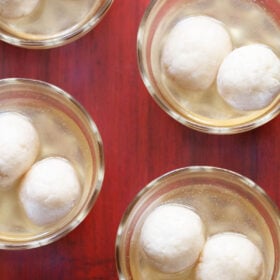
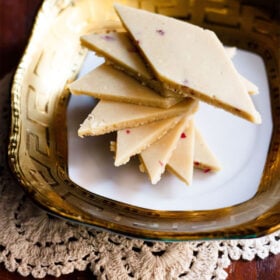








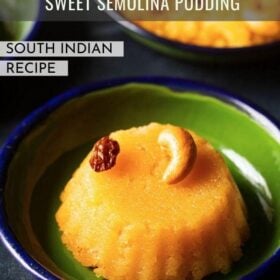
Nicely explained
Thank you.
Great recipe and thanks for the step to step guidance.
Welcome and thanks.
Excellent. Very tasty. yummy.
Can you roast the rava in ghee and prepare the seera for next day.
I am having puja so to avoid the long hours roasting can I roast it the previous day and keep it at room temperature and than make the seera next day morning.
Can you kindly reply me back
yes, you can do that. but when adding hot water to the rava, heat the rava again on a low flame so that it becomes hot when adding the hot water. hope this helps.
Wow super article , I tried and My Kesaribath became sticky:( how should we correct it in that case 🙁
looks like the rava was not roasted well. if the rava is not roasted well, the kesari can become sticky. while cooking some more water can be added and cooked for some more time. but nothing can be done after the kesari has been made.
I love your cooking! As a vegan i do not use milk. What can I use instead (esp. in deserts)? Great pictures! Really help!
thanks. when making vegan sweets at home, i use a neutral flavored oil or coconut oil instead of ghee. i use almond milk quite often as it gives an almost neutral taste and does not overpower the sweet. another alternative is cashew milk, though mostly i end up using almond milk. for a pudding or kheer, i use coconut milk and coconut oil. coconut milk gives a creamy thick texture and a flavor/taste that goes very well in kheer recipes.
Thank you for the recipe Dassana. Didn’t have saffron at home…I added raisins towards the end.
The dish turned out very soft and tasty…thanks for the detailed instructions.
welcome estee. saffron can be skipped. raisins can also be added towards the end. thanks for the feedback and nice to know.
Superb recipe rava kesari….tried so many times…Awesome dish!
Thanks Deepa for sharing your positive feedback.
Fan of all your recipes turned a good baker following most of your recipes,have tried rice varieties,north Indian recipes everything was a success thanks for your collection.
Welcome Smitha. Glad to know this. Thanks for your positive feedback and kind words.
Hi Dassana,
Tried rava kesari and the sooji halwa recipe. Both were so delicious. Have been following your recipes since a long time, and they never disappoint with the measurements or the flavour. Thank you so much.
Welcome Ritu. Glad to know this. Thanks for sharing positive feedback on recipes.
Can i use jaggery instead of sugar?
you can use jaggery in this recipe.
Very tasty. ..came out too good …thanks for sharing so briefly with posting detailed photos which helps us a lot .
thank you iileen for this feedback. nice to know.
Hi dassana
Can I use roasted upma rava for the kesari.
yes you can use roasted rava.
I am really thankful to you, I tried many sweet items which come out well.
pleased to know this thank you sheeba 🙂
Turned out awesome!!
thanks akshatha for sharing positive feedback on rava kesari.
Excellent recipe. I tried it for the first time and it turned out awesome. Thank you.
-Rahul
pleased to know this rahul 🙂 thankyou so much.
I have become your fan….tried several of ur recipies n all came out very well….Thank u sooo much….I really appreciate your effort n dedication…the pictorial steps help a lot….
thankyou for your kind and encouraging words god bless you remya 🙂 glad you found our food blog helpful.
Awesome
thankyou abi.
Hi
Just saw u r recipe they are so good Nd easy to make thanks for sharing.
I have a one in recipe you use cashew yogurt can we use cashew flour .
Thanks
Shashi
you can use cashew flour, but also add 1/2 tsp of lemon juice to give that faint sour taste in the recipe. you can also increase or decrease the amount of lemon juice as per your taste.
Hi dassana di,
Can i use condensed milk in this recipie?
Can you explain how?
i don’t thick condensed milk can use used in this recipe. you can use milk instead. just add the same amount of milk instead of water.
Dearest Dassana,
As you know, rava kesari is commonly made in Tamilian households. As a Mumbaikar now living in Coimbatore, we’ve tasted this dish many times here. After asking around for the recipe, I also tried making it at home a few times, but found considerable difference in the taste and texture.
Made rava kesari following your recipe just now and I’m so delighted to tell you that finally I got the authentic taste that has eluded me all this while. Thank you so much! God bless you! ☺
Love,
Neeti
welcome neeti. glad to know this. thanks for sharing your positive feedback and for your prayers.
Tried kesari (which was part of a thali dish) in one of the local South Indian restaurants and was curious about it. So I searched for the recipe and came across your website. I am not much of a cook and the recipe looked simple enough so I decided to try it. I followed the recipe exactly and it turned out PERFECT!
The step-by-step illustrations are very helpful. Thank you for the recipes.
welcome sita. glad to know this. thanks for sharing positive feedback.
I will try your method. Thank you.
welcome malinishunmugam
your recipes is super
thanks gowthami
Hi Dassana,
Today i have tried Reva kesari.For 1 cup rava,2 glass water is enough?
I tried with 2 cups of water but the rava was not cooked well,so again heat the 2 glass of water separately and mixed with Rava mixture…After that only it steamed well.
Could you pls correct me the water level. having added the hot water in between the reva mixture the taste is not good.Pls correct me
did you use 2 cups or 2 glass. 2 cups of 250 ml each is equal to 500 ml water. as a rule, you could add from 2 cups (500 ml) to 3 cups (750 ml) of water for any kesari recipe. if the rava is roasted very well, then its gets cooked also well in water. 2 cups is enough for 1 cup of rava. it also depends which rava you used. best is to use the fine rava and not the coarser ones. the taste does not come good when you mix hot water later is that by the time you heat water, the rava mixture cools down and when hot water is added, the rava becomes lumpy and does not cook well. so in such cases, you can just add the extra water at room temperature and cook the rava in it.
really i went through your recipes of Hotel type sambar for idlis and kesaribath amazing and awesome
Kindly requesting you to subscribe the new recipes to my mail id
thanks ramesh. i have added your name in subscriber list. you will receive a confirmation email to approve the subscription.
I will be attempting this for Holi this week. A few decades ago, I use to work for a private firm in Delhi, owned by a Tamil Brahmin family. The lady use to make this for every pooja she did, however she always added a well ripe mashed banana, along with the sugar mixture. That use to be real treat.
thanks ancy for sharing this info. in most poojas banana is added to halwa or sheera. i have already one post on banana halwa in the blog.
I was trying to make Kesari several times .., but your recipe was awesome .
And for the first time in my life., my kesari tastes exactly like south Indian kesari . Thank you very much .
Also Its my passion to try some weird experiments with my cooking .., so during my second attempt to make your recipe I added 400 Ml of pineapple Jam with the boiling sugar solution . .,and my friends and family ( they were the helpless victims of my cooking lab’s products 🙂 ) said that ..its tastes like a 5 star dish . Thank you so much
thanks lini for this positive review. good to know. i can imagine what pineapple jam must have done… am sure it must have been YUM 🙂
Three days holidays for self, wife and child. To pass time, made kesari as per receive, but added more dry fruits and little jeera and milagu also – more as a fun than as necessity. It also tasted well.
thanks for the feedback. i have seen some variations of kesari adding jeera.
Hi dassana….every time I make this.simple dish something goes wrong. So came here fully trusting nothing can go wrong. I was right. Came perfect. Thank you.
welcome famidha. thanks for showing trust. glad to know that it worked out well for you.
Can I know if we can add milk instead of water ? Will it be equally good as this recipe ?
gayathree, heat the milk and then add it, instead of water. it will taste good.
This is an awesome recipe 🙂
I did made some changes n it turned out pretty delicious
I combined white & brown sugar as per the measurement n half cup of cashew n the result was incredible.
Tq for sharing
welcome kay. glad to know this.
I made Rava Kesari exactly as per your site instructions, believe me it has come out really yummy. Slowly becoming a house-husband!!! Thanks a lot … Its a Vijaya Dasami offering to God ….
welcome satheesh. glad to know this.
I have had sheera in south indian restaurants (didnt know its called rava kesari). They also add cloves (lavang) to it and it tastes delicious.
This turned out to be good. I did add the cloves to emulate the restaurant taste but I hardly got the taste of it.. Have you tried using cloves ever?
thanks kashmira for your inputs. i don’t add cloves. i prefer the cardamom flavor.
Have tried many kesari bath recipes.. and this was the only one succeeded.. I got awesome response from my hubby…:) thanks a lot dassana..
welcome nisha. glad to know that you rava kesari recipe worked for you.
hi
i used to cook rawa but it used to never turn out the way it turned out from your recipe,the rawa was just perfect !!!!! thank you
thanks arusha.
Hi, I am planning to make this wonderful kesari for a group of friends. Can you tell me the measurements if I have to make this for around 17 people. I don’t wan’t to go wrong with my estimates.
for making a sweet like kesari, you can easily increase the recipe proportionately. generally as a ratio for 1 cup of rava, 1/2 cup ghee is used. the sugar can vary from 1 cup to 1.5 cups or more. this recipe served about 3 to 4 servings. so you can increase everything proportionately.
I Love rava kesari bath , thank u for showing this recipe
welcome sandhya
Can I get the ingredient measures.
you have to try the cup measures. for ingredient measures you will have to check online.
Wow ! it’s really tempting going to try this now thnx keep on doing this job
welcome geetha
Hello,
I am really thankful for the step by step guide to the recipie with pictures, and its really tempting. I tried it and really enjoyed it a lot..Thanks for posting such type of recipe.
rawa kesari is tooooooooo good
I love this dish. Thanks for the recipe!
Hello,
I am thankful for the step by step guide to the recipie with pictures, and its really tempting. I became fond of Kesribath when I was in Bangalore, and today I am through with the procedure and shall try out at home.Another favourite sweet dish is Obattu which is really relishing and I think most of the viewer will appreciate the dish if shown.
Thanks
L.I.Misra
Asst.Professor Dept.of Hotel Management
School of Hotel Management,SOA University
Bhuabneswar
Odisha
thanks a lot. do try the rava kesari. i know about obattu. on the blog there is puran poli – a maharashtrian dish, which is similar to obattu. link here – https://www.vegrecipesofindia.com/puran-poli-recipe/
I had been trying ravva kesari for many times and it never came out so well. And your recipe helped me a lot to make it look and taste so perfect and just the way my family likes it. Ravva Kesari came out really well. Thanks a lot.
welcome kranthi. nice to know that the rava kesari recipe was helpful to u.
hi dasana.love this recipe.In mauritius, we do this recipe during prayers, and nearly same ingredients and procedures like your recipe, only difference, we heat the semolina until light brown or we buy grilled semolina.I have never tried with ungrilled semolina..will the taste vary with grilled semolina? Anyway, ur recipe seems very good..will give it a try soon and will give the feedback.
by grilled semolina i think you mean pre roasted semolina. the taste will not vary. what you do is heat ghee and just lightly fry the semolina in ghee for a few minutes till they become aroamatic and the ghee starts to release. but don’t brown them. you won’t take long as mentioned in this recipe as here the semolina is not roasted.
So very well presented. The last photograph makes me want to have this now. Keep up the great work.
thanks hema
Dasanna,namaskara & thanks a million for sending such a wonderful & tasty recipes,today i am going to try Rawa halwa,once again thank you very much,please keep posting your latest recipes regularly.
Raju P.M, thanks for the encouraging comment. you can also subscribe to email updates or facebook or twitter to stay updated with latest recipes.
hi dasanna, its very tasty item,wen i hav seen pictures too tempting.thanq u soooooooo much 4 introducing dis recipe..
Welcome Hepsinithya Kaguturi
i tried your rava kesari recipe, it’s my first time cooking and my family loves it thanks 🙂
thanks radhika for the positive feedback on rava kesari recipe.
Hey Dassana,
The recipe is temptating. The sooji has taken the color of kesar…looks yummy. Will definately try this. I have also tried your Papaya halwa which tastes really good. On seeing the halwa everyone at home thought its a carrot halwa. Thanks for sharing.
the rava kesari is too good. do try it pratiksha. and thanks for the feedback on papaya halwa… it has become a favorite at home too.
You pictures are tempting particularly when it is a dessert ! i am totally in to the picture ! awesome !
thanks aparna